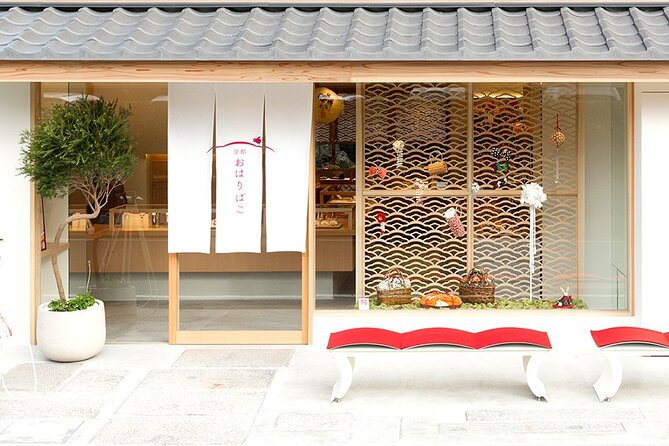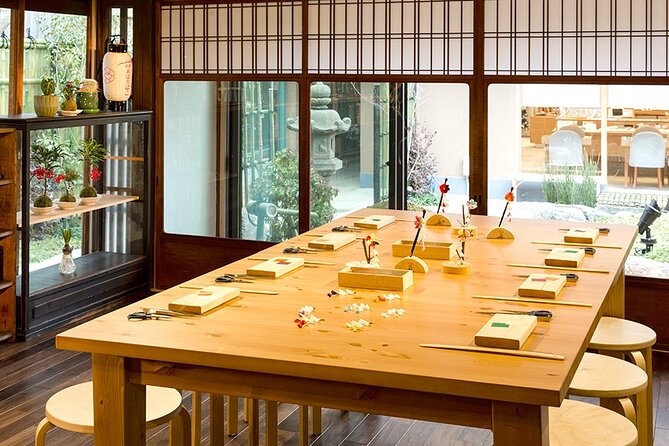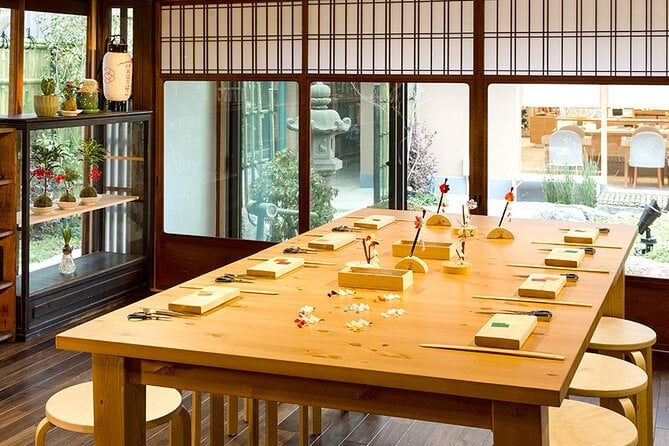Enjoy the captivating world of traditional Japanese kanzashi making during a hands-on workshop in Kyoto. At Kyoto Oharibako, skilled artisans guide participants through the intricate process of crafting their own kanzashi hair ornaments using high-quality materials. This intimate experience, limited to just ten people, allows you to connect with Japan’s rich cultural heritage and express your unique style through delicate designs. Unlock the secrets of this time-honored craft and uncover the symbolism behind each kanzashi creation.
Key Points

- Visitors can participate in hands-on kanzashi making workshops at Kyoto Oharibako, a center dedicated to preserving this traditional Japanese craft.
- The class provides all necessary materials, including high-quality silk, brocade, and metallic threads, as well as specialized tools like kushi sticks and wax paper.
- Participants will learn the intricate techniques of kanzashi folding and shaping, creating unique designs inspired by Japanese nature and symbolism.
- The intimate class setting with a maximum of 10 participants ensures personalized guidance from experienced instructors in the art of kanzashi making.
- The kanzashi making experience in Kyoto allows visitors to connect with the rich cultural heritage and craftsmanship of this traditional Japanese hairpiece.
What Is Kanzashi?

Kanzashi are traditional Japanese hairpieces that add beauty and elegance to formal hairstyles.
These intricate ornaments are made from a variety of materials, including silk, metal, and lacquered wood. Each kanzashi is carefully crafted, with intricate designs inspired by nature, such as flowers, leaves, and butterflies.
Kanzashi have been an essential part of traditional Japanese culture for centuries, worn by geisha, maiko, and brides on special occasions.
Today, the art of kanzashi making continues, with skilled artisans preserving this time-honored tradition and sharing it with visitors to Kyoto.
You can also read our reviews of more tours and experiences in Kyoto.
History of Kanzashi
The origins of these intricate Japanese hairpieces can be traced back to the Heian period (794-1185 CE), when they were first used by the imperial court and aristocratic women to adorn their elaborate hairstyles.
Over time, the designs and materials evolved, reflecting the aesthetics and cultural influences of different eras. Kanzashi became a symbol of refinement and social status, with skilled artisans crafting these delicate ornaments using materials like silk, lacquer, and precious metals.
Today, the tradition continues, with kanzashi serving as both functional and decorative elements in Japanese culture.
Materials and Tools for Kanzashi Making

Crafting kanzashi requires a specialized assortment of materials and tools. These include high-quality silk fabric, brocade, and metallic threads for the decorative elements.
Sharpened scissors, tweezers, and needles are essential for precise cutting and shaping. Specialty kanzashi sticks, called kushi, come in various sizes and shapes to hold the intricate folds and forms.
Wax paper helps achieve smooth, crisp creases. Learners will also use adhesives, padded mats, and templates to ensure their kanzashi masterpieces take shape correctly.
With the right materials and expert guidance, participants can create their own exquisite Japanese hair accessories.
The Kanzashi Making Process

Participants begin the kanzashi making experience by selecting their desired fabric and color palette.
An instructor demonstrates the intricate folding techniques, guiding them through each step.
With deft fingers, participants carefully shape the fabric into delicate petals and loops, assembling the components to create a unique kanzashi hair ornament.
The instructor offers personalized advice, ensuring each participant’s work is precise and visually striking.
As the session progresses, the once flat fabric transforms into a vibrant, three-dimensional piece of traditional Japanese art.
Symbolism and Meaning in Kanzashi Designs

Kanzashi designs hold deep symbolic meanings rooted in Japanese culture and tradition. The intricate patterns, shapes, and materials used in these hair ornaments convey specific meanings and represent important cultural concepts.
| Symbol | Meaning | Significance |
|---|---|---|
| Butterfly | Grace, beauty, transformation | Represents the transition from caterpillar to butterfly, a metaphor for personal growth. |
| Cherry Blossom | Transience, beauty, impermanence | Symbolizes the fleeting nature of life and the appreciation of the present moment. |
| Bamboo | Resilience, flexibility, longevity | Represents the ability to bend without breaking, a quality admired in Japanese culture. |
The symbolic language of kanzashi allows wearers to express their identity, aspirations, and connection to Japanese heritage.
Variations and Styles of Kanzashi
Beyond the symbolic meanings, kanzashi come in a wide range of styles and variations that showcase the artistry and diversity of this traditional Japanese craft.
From ornate, intricate designs to simple, elegant forms, kanzashi can feature delicate flowers, geometric patterns, or abstract shapes. The materials used, such as silk, metal, and lacquer, also contribute to the overall aesthetic.
Regional styles, like the Kyoto-style kanzashi, have their own distinct characteristics. This versatility allows kanzashi artisans to create pieces that cater to individual preferences and occasions, making each one a unique expression of Japanese culture.
The Kanzashi Making Experience in Kyoto
What better way to take in the rich cultural heritage of Kyoto than by partaking in a traditional kanzashi making experience?
Located at Kyoto Oharibako, this hands-on activity allows visitors to create their own exquisite kanzashi hair ornaments under the guidance of skilled artisans.
The experience includes:
- All necessary materials for the activity
- Maximum of 10 participants for an intimate setting
- Accessibility for strollers and service animals
- Convenient proximity to public transportation
At just $29.61 per person, this kanzashi making class offers a unique opportunity to connect with Japan’s time-honored traditions and craftsmanship.
Preserving the Kanzashi Tradition
Nestled within the rich cultural landscape of Kyoto, the kanzashi making experience at Kyoto Oharibako serves as a testament to the unwavering dedication of artisans in preserving this captivating tradition.
Participants are immersed in the intricate process of crafting these ornamental hair accessories, learning from skilled instructors the techniques that have been passed down through generations.
By offering this hands-on experience, the studio ensures the preservation of kanzashi-making, safeguarding a unique aspect of Japan’s artistic heritage.
Each delicately created piece is a reflection of the artisans’ meticulous attention to detail and commitment to upholding this time-honored craft.
Frequently Asked Questions
Can I Take the Finished Kanzashi Home?
Yes, participants can take the kanzashi they make home with them. The experience includes all necessary materials, and travelers are able to keep their finished creations after the activity.
Is This Activity Suitable for Children?
The activity is generally suitable for children. Children can participate in the Kanzashi making, but they’ll need close supervision due to the small materials involved. It’s a fun, creative experience that all ages can enjoy.
Can I Customize the Kanzashi Design?
Yes, participants can typically customize the kanzashi design during the activity. The provider offers guidance on traditional techniques while allowing creativity, so travelers can personalize their handmade kanzashi hair ornament.
How Long Does the Activity Typically Last?
The activity typically lasts around 1.5-2 hours, allowing participants ample time to create their own unique kanzashi hair ornaments under the guidance of the experienced instructors.
Are There Any Discounts or Packages Available?
The experience provider offers package deals that provide discounts for groups. Travelers can also reserve their spot without paying upfront, allowing for flexible booking. Additional discounts may be available during certain seasons or for last-minute bookings.
Recap
Immersing oneself in the art of traditional Japanese kanzashi-making in Kyoto provides a unique opportunity to connect with Japan’s rich cultural heritage. Guided by skilled artisans, participants create their own intricate kanzashi designs, expressing their identity while preserving this time-honored craft. The intimate workshop setting fosters a deeper appreciation for Japanese craftsmanship, making it a truly memorable and meaningful experience.
More Tour Reviews in Kyoto
- The Art of Geisha: Exclusive Show & Traditional Japanese Game
- Tea Ceremony With Kimono and Professional Photoshoot in Kyoto
- Kyoto Arashiyama Bamboo Forest Hidden Hiking Tour
- Kyoto Early Morning Walking Tour: Nature & History
- Small-Group Dinner Experience in Kyoto With Maiko and Geisha
- Private Kyoto Night Tour: Historic Walk at Gion and Fushimi
Not for you? Here's more things to do in Kyoto we have recnetly reviewed
- 5 Best Cruises And Boat Tours In Kyoto
- 14 Best Dining Experiences In Kyoto
- 20 Best Full-Day Tours In Kyoto
- 5 Best 2 Day Tours In Kyoto
- 2 Best 4 Day Tours In Kyoto
- 20 Best Photography Experiences In Kyoto
- 13 Best Dinner Tours In Kyoto
- 25 Best Food Tours In Kyoto
- 14 Best Lunch Experiences In Kyoto
- Kyoto Bus Tour: Iconic KInkakuji, Ginkakuji, Kiyomizu Temple (AW)
- Kyoto Bus Tour: Arashiyama, Kinkaku-ji Review
- Gyoza Cooking Class in Kyoto: Traditional Japanese Dumplings
